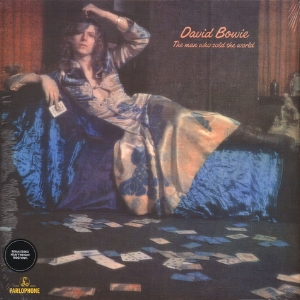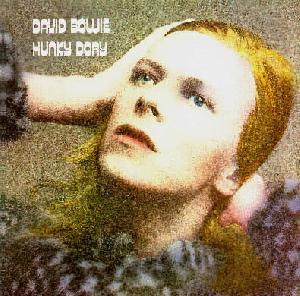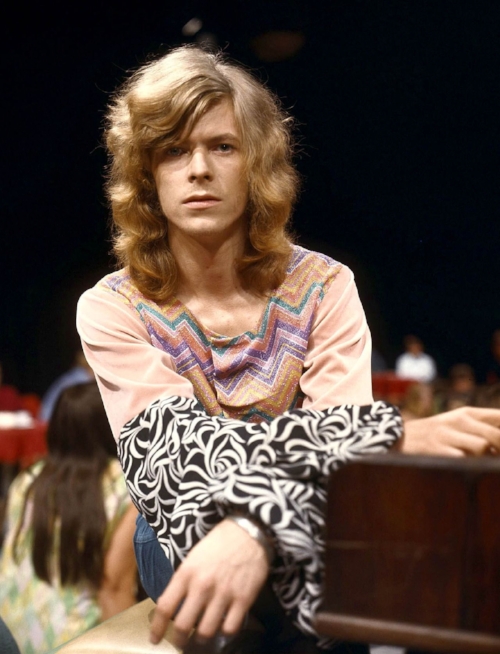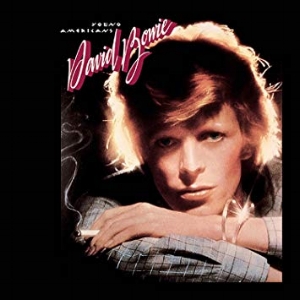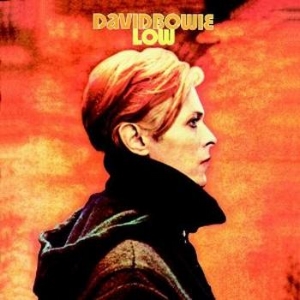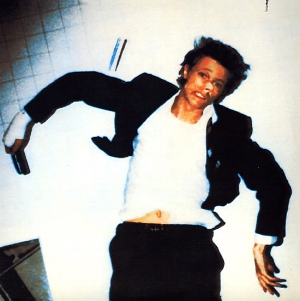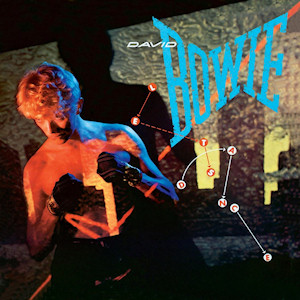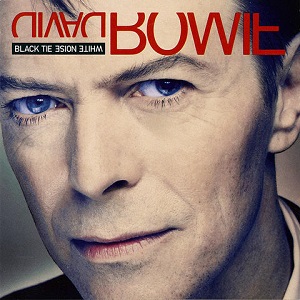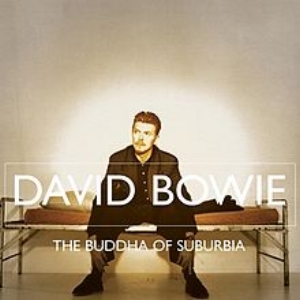Fantastic Voyage: A Deep Dive Retrospective of David Bowie
Listen to the playlist on the streaming service of your choice as you read along.
When David Bowie died in 2016 it was unexpected but not entirely surprising. He'd been laid up with a heart problem years before and, after 50 years in rock n' roll, the body can only take so much. But having just celebrated his 69th birthday and released his 25th solo album days before, the timing of his death was certainly upsetting.
The attention paid to his passing was fitting but unsatisfactory. No amount of column space or evening news coverage could properly speak to his career. Certainly, everything said about him was true. He was a music legend, a fashion icon, an actor, a trendsetter, a sexual liberator, and an individual of never-ending fascination. So taking all that into account my one complaint was that, while his music was certainly noted, there wasn't enough acknowledgment given to the fact that he was an excellent musician, singer, and songwriter. The obituaries seemed to suggest he was famous for being unconventional, while ignoring the fact that many people are unconventional, but almost no one succeeded or gained the artistic status of David Bowie. Why? The music. If you're attracted to someone for being original and intriguing, and then find their art wanting, you move on. When people came to David Bowie, they stayed. Rockers, dancers, individuals, groupies, wannabes, freaks, loners, the cool, the geeky, the indifferent or the keeners, when you came in touch with Bowie, the chances are you were hooked. David Bowie was the first celebrity death that made me cry. I listened to his music non-stop for 3 days after hearing the news. My reaction surprised me a little, but really should not have, given I’ve been listening to him passionately since I was a young boy.
The Playlist - Song\Album (year)
Mop-topped in the ‘60s
You've Got A Habit of Leaving \ Non-album single (1965)
There is A Happy Land \ David Bowie (1967)
The Wild Eyed Boy from Freecloud \ Space Oddity (1969)
God Knows I'm Good \ Space Oddity (1969)
All the Madmen \ The Man Who Sold the World (1970)
The Supermen \ The Man Who Sold the World (1970)
Kooks \ Hunky Dory (1971)
Quicksand \ Hunky Dory (1971)
Queen Bitch \ Hunky Dory (1971)
Moonage Daydream \ The Rise and Fall of Ziggy Stardust and the Spiders from Mars (1972)
Star \ The Rise and Fall of Ziggy Stardust and the Spiders from Mars (1972)
Hang on to Yourself \ The Rise and Fall of Ziggy Stardust and the Spiders from Mars (1972)
Watch that Man \ Aladdin Sane (1973)
Panic in Detroit \ Aladdin Sane (1973)
Lady Grinning Soul \ Aladdin Sane (1973)
Sweet Thing \ Diamond Dogs (1974)
Rock n’ Roll with Me \ Diamond Dogs (1974)
Win \ Young Americans (1975)
Fascination \ Young Americans (1975)
Can You Hear Me \ Young Americans (1975)
Word on A Wing \ Station to Station (1976)
Speed of Life \ Low (1977)
Always Crashing in the Same Car \ Low (1977)
Joe the Lion \ “Heroes” (1977)
The Secret Life of Arabia \ “Heroes” (1977)
Fantastic Voyage \ Lodger (1979)
Move On \ Lodger (1979)
It’s No Game (Part 1) \ Scary Monsters and Super Creeps (1980)
Scream Like A Baby \ Scary Monsters and Super Creeps (1980)
Because You’re Young \ Scary Monsters and Super Creeps (1980)
Ricochet \ Let’s Dance (1983)
Criminal World \ Let’s Dance (1983)
Don’t Look Down \ Tonight (1984)
Tumble and Twirl \ Tonight (1984)
Beat of Your Drum \ Never Let Me Down (1987)
Amazing \ Tin Machine I (1989)
Nite Flights \ Black Tie White Noise (1993)
Untitled No. 1 \ The Buddha of Suburbia (1993)
Outside \ Outside (1995)
I Have Not Been to Oxford Town \ Outside (1995)
Looking for Satellites \ Earthling (1997)
Law (Earthlings on Fire) \ Earthling (1997)
Something in the Air \ ‘Hours’ (1999)
New Angels of Promise \ ‘Hours’ (1999)
The Dreamers \ ‘Hours’ (1999)
5.15 The Angels Have Gone \ Heathen (2002)
Heathen (The Rays) \ Heathen (2002)
Days \ Reality (2003)
Bring Me the Disco King \ Reality (2003)
If You Can See Me \ The Next Day (2013)
I’d Rather Be High \ The Next Day (2013)
‘Tis A Pity She Was A Whore \ ★ (2016)
Dollar Days \ ★ (2016)
Any retrospective of his career will be insufficient since there’s just too much to explore, but as I like to do with well-known artists, a deep dive reveals much while still a satisfying listen, and lessens the distraction of the mega hits and songs you’ve heard a thousand times (though many a fan will have heard these songs a plenty too). So let’s journey through his musical career, set-up in the following chapters: Folk Freak, The Personas, The Berlin Trilogy, Pop Star, and Elder Statesman.
Folk Freak
You’ve Got a Habit of Leaving \ Non-album single (1965)
David Bowie, whose real name was David Jones (he renamed himself because of confusion with Davy Jones of The Monkees, taking his name from James Bowie, the inventor of the Bowie knife) started like many another artistically inclined young men in 1960’s England. He was the product of an art school education and tried his hand at several avenues of expression, including acting and mime (he studied under the recently deceased Lindsay Kemp, a leading practitioner, and was quite good at it apparently – there’s currently a movie being made about these years). But music held David’s attention most and he learned to play guitar and sax, but most of all he developed a distinctive and compelling singing voice.
Over the course of this playlist there will only be one common thread, his voice. David Bowie could sing a nursery rhyme and it would sound amazing. He has one of the most distinctive and coolest sounding voices in the history of music. He can rage, he can sooth, he can go high and he can whisper – and always his voice demands attention. If there’s a secret to how he’s been able to move through different styles over time and always sound great, it’s his voice.
Bowie, as Davy Jones, first started performing as a member of a straightforward rock band called The Lower Third. Despite releasing several singles such as “You've Got a Habit of Leaving” they were unable to gain traction.
There is A Happy Land \ David Bowie (1967)
Going solo, Bowie’s music, in the tradition of the singer-songwriter mold, turned more acoustic and folk, and his self-titled album showed his knack for great lyricism and melody, such as in “Love You ‘til Tuesday,” a song that in a few years would be used as the title of a movie. He also had a penchant for whimsical turns, often including humour and odd bits into his songs, most notably in the single “The Laughing Gnome” or in the album’s last song, “Please Mr. Gravedigger,” in which David sounded like he was singing with a bad cold. At the end of this album track, “There is A Happy Land,” you can hear a bit of this whimsy in the final moments of the song. At this point it was uncertain whether Bowie was an artist to take very seriously.
The Wild Eyed Boy from Freecloud; God Knows I’m Good \ Space Oddity (1969)
Perhaps one reason the obits for Bowie focused on him more than his music was, despite all his originality, the music itself was never ground breaking. All his music was excellent, but as time moved on he, like a chameleon, moved along with the trends and - amazingly and without irony - excelled at each style and won fans over while (mostly) keeping his existing fans. So, in the 1960s his music was a product of its times, moving through rock and folk.
The second album was preceded by a single that launched young David from the multitude of acoustic rockers into a hitmaker. On July 20, 1969 man made its first step on the moon, and the story of Major Tom, as told in “Space Oddity,” would be the perfect soundtrack to the marvel of that event, even if the song was about a space emergency. Led by the success of the single and title track, Space Oddity the album got Bowie significant more attention and people were exposed to his earnest and engaging songs such as “God Knows I'm Good.” The album also had several more ambitious songs with greater arrangements, such as “The Wild Eyed Boy from Freecloud,” showing he had an ability to write songs of greater ambition than the folk-based songs of his earlier work. It was joined by the likes of “Unwashed and Somewhat Slightly Dazed,” “Cygnet Committee,” and “Memory of a Free Festival.” It also had to be noted the album was great, from start to finish and lost the whimsy of his debut in place of a more serious tone.
All the Madmen; The Supermen \ The Man Who Sold The World (1970)
As he moved on to his third album, Bowie was also now being known more notoriously for his image. To the conservative press and staid British audiences, this young crooner was simply a freak. His gaunt, pale, angular face was adorned with long, feminine blond hair and his outfits were androgynous – was this a boy or a girl? Indeed, on the cover of The Man Who Sold the World, he was wearing a dress, an image many a record store was afraid to put on display. If that wasn’t scandalous enough for the times, Bowie heightened the shock in interviews a few years later when he was open about his bisexuality, which was at a time no one was coming out. He was not yet a star, seen as a strange one-hit wonder after “Space Oddity.”
The sound on this album was much fuller and the guitar licks he’d be known for shortly were starting to appear more frequently, tilting this album more decidedly towards rock than folk. He was getting his legs under him, opening his sound to broader landscapes, and of course responding to the ascendency of rock music as the ‘60s gave way to the new decade.
Kooks; Quicksand; Queen Bitch \ Hunky Dory (1971)
Therefore, when Hunky Dory came out, it was a bit surprising to hear him lean back more towards folk-rock. His image was again androgynous with full, feminine hair, and he continued to be seen as an oddity (in space or otherwise). In 1971, rock n’ roll was the order of the day and folk music, while still going strong, was being relegated to the sidelines. However, there were undeniable moments on this album that asserted this young man as someone to be reckoned with. So while this LP wasn’t a huge success at the time, in time it would come to be recognized as an all-time great, and one many fans argue was his best (these assertions always depend on which of Bowie’s sounds you like best). The charts and greatest hits packages would recognize “Changes” as the notable track from this album, as a standout single and lyrically a Dylanesque touchstone of the times. “Queen Bitch” jumped out as another sign of the more aggressive sound to come. However, history now focuses on one song more than the others on this album; indeed, after his death what was the one song many used to pay tribute as an example of his exquisite song writing and as the consummate Bowie song? “Life on Mars,” which brought the broader compositional style into perfect harmony with his folk-rock style.
Bowie in 1970
The Personas
Moonage Daydream; Star; Hang On to Yourself \ The Rise and Fall of Ziggy Stardust and the Spiders from Mars (1972)
Ziggy Stardust
Bowie was now working with Mick Ronson on guitar and through him exploring a fuller rock sound. Together, and with the creative drive of his new wife Angela Bowie, they were also pushing boundaries of fashion and expression. It was from this mix the idea arose to do a concept album unlike any that had come before. The idea of a cohesive album had been around since The Beatles came out with Sargeant Pepper in 1967, and The Who had done Tommy in 1969 which popularized the idea of the rock opera, but The Rise and Fall of Ziggy Stardust and the Spiders from Mars was something else. The entire album told a story about a rock star alien, but in this case David Bowie assumed the role and, for the purposes of the album and tour, became Ziggy Stardust. As Ziggy, Bowie launched the whole notion of Glam Rock by introducing costumes, make up, and performance along with the music (and a bright red hairdo that was supposed to be alien but today would be noted as a legendary mullet). It was the fruition of his art school years and training and the fullest expression yet of his unique artistic vision.
Ziggy Stardust is found on any published list of greatest rock albums. The music was now fully formed, rich and big, and spanned out from his subtler folk sound to a muscular rock sound, such as in “Suffragette City” and the title track. The perfect blend of folk, blues, rock, and soul in songs like “Five Years,” “Soul Love,” and “Starman,” hooked huge audiences for the 25 year-old singer. The songs were also full of drama and varied energy, not allowing for a single dull moment throughout the album. Finding deep tracks on this LP is a bit of lost cause, since it’s so well known, but “Moonage Daydream,” “Star,” and “Hang on to Yourself” capture the varied elements of the album and just how strong the music was throughout.
Conceptually the album took the listener on a musical and lyrical journey, and in doing so made David Bowie a rock star. Perhaps by becoming an alien character, it made his freakishness more palatable and him more approachable as an artist. However, the idea of Bowie being an alien persisted – not entirely helped by him actually playing an alien in the 1976 movie, The Man Who Fell to Earth, by him constantly returning to the topic of space in his lyrics, and by having different coloured eyes (at least, they appeared that way due to a childhood condition) – and many believe he truly was not of this world… seriously.
This was also a prolific period of song writing and producing for Bowie. He casually threw out classics like, “John, I'm Only Dancing,” a leftover from the Ziggy recording sessions, and gave away “All the Young Dudes” to an unknown glam band called Mott the Hoople, of which he was a big fan and were about to break up. Bowie’s song and the album of the same name, which he produced, saved the band and gave them a rock classic to build their career around. He als co-produced, with Mick Ronson, Lou Reed’s seminal album, Transformer, and co-produced with Iggy Pop The Stooges’ 1973 album, Raw Power. For him to have had his hand on so many legendary albums in a two year period was simply remarkable.
Watch that Man; Panic in Detroit; Lady Grinning Soul \ Aladdin Sane (1973)
Bowie also continued to tour, record new music with The Spiders from Mars band, and reap the benefits of rock fans’ fascination with Ziggy. But again it was the music that sustained as he and the band released his sixth album, Aladdin Sane, forever known by the iconic picture of Bowie with the lightning bolt across his face. Adding “The Jean Genie” to his growing list of standout songs, the album also ensured it would be another all-time classic, with energy in songs such as “Watch that Man” and “Panic in Detroit,” and stirring grace in the album’s closing track, “Lady Grinning Soul.”
Not many people could put out two such incredible albums in a row, and Bowie’s star was shining as bright as ever, supporting a growing expanse of glam bands in which costumes and make up were no longer the mark of fringe artists but dominating the charts and stages. Aladdin Sane would be his first #1 album in the UK and second to crack the top 20 in the US. “The Jean Genie” and “Drive-In Saturday” were his third and fourth top ten hits, though a #1 single hadn’t arrived yet despite the growing stature of his music. In the US he was still growing his audience and not charting well, though a re-release of “Space Oddity” got to #15. Similarly the release of “Life On Mars” brought the brilliance of Hunky Dory to a larger audience as the single reached #3 in the UK.
Sweet Thing; Rock n’ Roll With Me \ Diamond Dogs (1974)
At that time Bowie oddly chose to release an album of cover songs called Pin Ups in order to bring attention to American audiences of UK artists and other songs he thought should be acknowledged. It was his second #1 album in the UK and reached #23 in the US, similar to his prior two albums.
Looking to move on with his career, Bowie abruptly retired the Ziggy character onstage at the end of his two-year tour. The Diamond Dogs album that next came out in 1974 featured a new Bowie persona and a new sound that he labelled “Plastic Soul.” Appearing as a golden, half-man\half-dog on the album (you had to open the album gatefold to see the full picture), Bowie started to show a more refined image on stage and his music, while still rocking with instant classics such as “Rebel Rebel,” also started to explore more straight-ahead R&B and soul. This album was also another concept album, built around George Orwell’s book, 1984. It also started to range his music into more experimental sequences, something that would come to fuller fruition a couple of years later. It featured a three song medley on the first side, “Sweet Thing/Candidate/Sweet Thing (reprise)” that led into the iconic guitar intro of “Rebel Rebel” for the closing tune.
Win; Fascination; Can You Hear Me \ Young Americans (1975)
Word on A Wing \ Station to Station (1976)
The new R&B sound was explored further in the next album, Young Americans, one in which Bowie rediscovered his love of the sax and brought in gospel-like back-up singers. Funk infused the hit, “Fame” (co-written with John Lennon), jazz and gospel seeped into the title track, and the full-band sound of ‘70s rock emanated from the lush sounds of “Win,” “Can You Hear Me,” and the sublime cover of the Beatles’ “Across the Universe;” there was even the first hints of disco with “Fascination.”
I never warmed up much to “Fame” (though acknowledge it’s a pretty cool song), but “Young Americans” remains one of my all-time favourite songs and was the song that I first started developing my love for Bowie, when my brother gave me the greatest hits album, ChangesOne, for my birthday in 1982. Like my other great musical hero of this era, Bruce Springsteen, the use of sax with a broad rock sound just took the music to another level, and the albums coincidentally featured ex-Springsteen guitarist, Carlos Alomar, The Boss’ piano player, Roy Bittan, and while Bowie often played his own sax parts, the Young Americans album was boosted by the fantastic contributions of David Sanborn. This was the quintessential rock sound of the mid-‘70s, and once again David Bowie captured it as well or better than anyone.
The Thin White Duke
Along with the new sound emerged Bowie’s next persona, The Thin White Duke, the subject of the title song of his next album, Station to Station. This character was a gaunt figure in suits (often white), slicked back hair, sometimes topped with a hat and harkened back to the era of blues and jazz clubs in early 20th century America. Again the sounds of the ‘70s were explored, with a nod to prog rock with the 10-minute title track, a beautiful, dramatic, cover of “Wild is the Wind,” funked up songs like “Golden Years,” soul-dance numbers like “Stay,” and lovely little piano-laced tunes like, “Word on A Wing.”
The Berlin Trilogy
Speed of Life; Always Crashing in the Same Car \ Low (1977)
David Bowie in 1976 had just released a string of six albums in six years that made him a huge star. They had all gone top 5 in the UK, including three #1 spots, and the last three albums had cracked the top ten in the US. “Fame” became his first #1 single, hitting that spot, a bit surprisingly, in the US. “Space Oddity” again climbed the charts in the UK in 1975, this time giving Bowie his first #1 hit in his homeland. The songs off these albums are one of the greatest collections of rock songs by any artist, and at this point he was only 29 years old. He was living in Los Angeles and enjoying the life of a rock star, which stereotypically came with a serious cocaine addiction, a tempestuous relationship with his wife, and the challenges of being one of the most recognizable people on the planet – whether as himself, Ziggy or The Thin White Duke. He decided he needed a change in scenery.
Intrigued by the German art scene and the burgeoning experimental electronic sounds coming from there, he retreated to Berlin. He stayed there for two and a half years and released three albums. The first of these was the experimental album, Low, created with producer, co-creator, and electronics pioneer, Brian Eno (also ex of Glam rockers Roxy Music and future producer extraordinaire of U2). The first side was standard, solid Bowie songs that included the singles “Sound and Vision” and “Be My Wife” as well as engaging tunes like the instrumental opener “Speed of Life” and the subtle lament of “Always Crashing in the Same Car.” The entire second half of the album, however, was ambient, with electronic and organ sounds that created surreal aural landscapes. For an artist of Bowie’s stature, this was a sudden and puzzling change to his fans. The musical interludes of Diamond Dogs was now a major feature of the album.
Joe the Lion; The Secret Life of Arabia \ “Heroes” (1977)
During 1977 Bowie also connected with Iggy Pop and helped pull the ex-Stooges singer out of a drugged-out stupor. Bowie co-wrote and produced Pop’s first two solo albums, The Idiot, and Lust for Life, both released that year. Once again Bowie had his hand in albums and songs that are widely regarded as classics.
Experimentation with instrumental, electronic music continued on the second album in Berlin, “Heroes,” amazingly also released in 1977 (that’s four great albums he worked on in one year). And while much of the album again strained against the norms of current music styles and befuddled his fans, much would be forgiven due to the brilliance of the title track. Rolling Stone magazine recognizes “Heroes” as the 46th greatest rock song of all time, while British publication The New Musical Express (NME) places it at 15th. The song seemed to be the perfect mix of classic Bowie rock and the experimental sounds of his Berlin interlude. If you are interested, check out this video by long time Bowie producer, Tony Visconti, about the recording of this song.
Again the album was a first side of standard songs followed by a second side of ambient music. “Joe the Lion” followed “Beauty and the Beast” (the album’s second single after the title track) and was evident of the harder edged rock of the album, as horns and R&B hooks gave way to guitar-driven sonics. The second side though, does finish with “The Secret Life of Arabia,” a grooved out, funk-laden tune seemingly pulled from the Thin White Duke era.
Fantastic Voyage; Move On \ Lodger (1979)
After releasing two albums in the same year the third album from Berlin, Lodger, emerged a little more than a year later in 1979. There were more standard format rock songs on this album but still included experimental moments, though less atmospheric and more rhythm based, like “African Night Flight,” “Repetition,” and “Red Money.”
Despite there being more traditional and quality rock songs on this album, for many fans his music was getting inaccessible, and less devoted fans didn’t warm up to singles like “DJ” or “Look Back in Anger” and certainly less so for the experimental indulgences on the albums. “Fantastic Voyage” and “Move On” were indicative of the style of tunes on Lodger, blending his rock and R&B with more rhythm.
The Berlin trilogy is now seen as an integral and important part of Bowie’s career. While the albums all reached the top five in the UK, they dropped off in the US with chart positions of #11, #35, and #20. “Sound and Vision” and “Boys Keep Swinging” both reached the top ten in the UK, but only “Sound and Vision” charted at all in the US and only to #69. To have an artist of his stature embracing and trying the new electronic formats of the times must have played a role in the wave of synth music that came immediately after. Berlin was an influential period on Bowie and to many others beyond, as it was one of the rare periods he moved to the forefront of emerging musical styles.
Pop Star
It’s No Game (Part 1); Scream Like A Baby; Because You’re Young \ Scary Monsters and Super Creeps (1980)
Coming out of Berlin the next phase of Bowie’s career is debated among fans. Some will say that 1980’s album, Scary Monsters and Super Creeps, was when Bowie sold out and went down the road to ‘has been’, while others will argue it was 1983’s follow-up, Let’s Dance or any of his other 1980s output that rendered him a pariah to his former self. Of course, with David Bowie it’s never straightforward. What is typically ironic with these assertions of declining quality is that his music reached the zenith of popularity and commercial success during this period.
Scary Monsters was unquestionably a return to form for Bowie in terms of moving away from the esoteric experimentation of his Berlin albums. Perhaps after garnering respect and admiration for the non-commercial detour of his career, to return to a standard rock format would be seen by some as ‘selling out,’ whatever that means. Regardless, the album and its singles, like all throughout his career, was of its times: “Fashion” tipped a hat to the disco and funk sounds of the past few years, “Ashes to Ashes” hinted at the emerging new wave sound, and “Teenage Wildlife” fit right in with the big band rock of the 1970s. The music was still Bowie, through and through, but this time there was no pretense, no persona – just David Bowie as himself, the enigmatic, unpredictable, and unique artist (and still up to strange things, per the ‘Ashes to Ashes’ video). The mix of sounds was also evident in the album tracks of this playlist, with some of the avant-garde rock in “It’s No Game,” and the modern rock sounds of “Scream Like A Baby” and “Because You’re Young.”
Scary Monsters also returned Bowie to the top of the rock world, reaching #1 in the UK and #12 in the US, with the title track going to #1 in the UK (his second #1 hit) and “Fashion” reaching #5 (the US still hadn’t warmed back up too much to his singles).
David returned to his mime look for the “Ashes to Ashes” video
Ricochet; Criminal World \ Let’s Dance (1983)
Returning to the limelight and top of the charts after a monster hit with Queen in 1981, “Under Pressure,” Bowie was now embracing a stage of his career with nothing to prove. Newly divorced, a little healthier and less under the spell of intoxicants, his music lost some of the edge and experimentation and moved into a straight-ahead pop sound. For some fans this was unforgiveable, for a new generation of young people it was some of the greatest music around. Perspective is everything.
Let’s Dance was one of the biggest albums around in 1983-84, once again making Bowie a worldwide star. The album went to #1 in the UK and many other countries, and #4 in the US (at that point Station to Station was oddly his best charting album stateside, having reached #3) and featured three top ten singles in the UK and the US: “Let’s Dance (#1 in the UK), “China Girl,” and “Modern Love.” He was part of a last wave of ‘70s rockers getting their final licks in before being pushed aside. The Rolling Stones, Bruce Springsteen, The Kinks, Paul McCartney, John Lennon, Pink Floyd, Led Zeppelin, Queen, The Clash, Tina Turner, and The Who all had huge success in the years between 1980-1984 that they would never again be able to achieve, leading most of them to call it quits.
With curly, bright blonde hair and stylishly cut suits (for the 80s), he was as approachable and as appealing as he’d ever been. If there ever was an artist positioned to benefit from the MTV, video-driven era, it was David Bowie. His ‘Serious Moonlight’ tour went on for two years and Let’s Dance would be the biggest selling album of Bowie’s career, bringing him a huge audience of casual fans along with his existing army of die-hards. It’s difficult to find deep cuts from this album since most were issued as singles (the entire first side of the LP) or in soundtracks (“Cat People (Putting Out Fire)” was from the Nastassja Kinski and Malcolm McDowell movie, Cat People). However, the engaging rhythms of “Ricochet” and “Criminal World” reveal the more accessible style of Bowie’s music on this album, though they lack the pure pop brilliance of the huge singles from the album.
Permed, blow dried, and suited for the 1980s
Don’t Look Down; Tumble and Twirl \ Tonight (1984)
Beat of Your Drum \ Never Let Me Down (1987)
In the shadow of the success of Let’s Dance the next album, Tonight, failed to hold the zeitgeist. The lead single, “Blue Jean,” made little noise (but had a fun, long form video) while the duet with Tina Turner on the title track was only notable for the intriguing duet and music built on island rhythms. Perhaps what’s most interesting on this album was Bowie’s return to working with Iggy Pop, but this time recording many of Iggy’s songs (as he’d done on the prior album with “China Girl”). But it appeared that Let’s Dance was the zenith, a pinnacle so high that Bowie would never again be able to achieve the same level of commercial or critical success. The summaries of his career barely mention his music past this point. It’s really a decent album, and songs like the moody “Don’t Look Down” or the Style Council-like “Tumble and Twirl” show the quality of the songs; and then there was his cover of the Beach Boys classic, “God Only Knows,” to which Bowie did proper justice.
During the ‘80s Bowie ramped up his acting career. After his turn as an alien in 1976 he’d only done some cameos and bits in movies, but in 1983 he played leading roles in two movies, Merry Christmas Mr. Lawrence and The Hunger. The latter became a cult classic as he played a vampire couple with esteemed French actress Catherine Deneuve, in which together they seduce a young American played by Susan Sarandon. The movie also featured a live performance by legendary goth band, Bauhaus, doing their most notable song “Bella Lugosi’s Dead.” In 1986 Bowie starred in two more movies, one a musical called Absolute Beginners, in which he provided the fantastic title track, and another a fantasy called Labyrinth in which he played a goblin king and provided all the music. Both bombed at the box office but Labyrinth would become a cult favourite over the years. In many respects, Bowie was cashing in on his theatrical history and using his personas in film instead of song. “This is Not America” was another strong single during this time as a contribution to a spy thriller, Falcon and the Snowman, starring Sean Penn and Timothy Hutton and was a recording with Jazz musician Pat Metheny.
After dominating the first half of the decade, the rest of the ‘80s would not be kind to David Bowie. His 1987 album Never Let Me Down is widely noted as the low point of his career. While his movie music had been elegant and rich, on this album he plumbed the depths of uninspired, shallow ‘80s pop music, driven by electronics and devoid of his usual melody. Yet “Day-in Day-Out” still enjoyed chart success, built on his reputation and, as usual, its fit with the times. Regardless, in this period as a pop-lite and faraway version of his former self, Bowie in later years would even acknowledge this was a weak period in his career as he tried to appeal to the new legion of casual fans he’d won over with Let’s Dance. His pairing in 1985 with Mick Jagger singing Marvin Gaye’s Motown standard “Dancing in the Street” was an embarrassment for artists of their stature – unfortunately they chose to debut it at Live Aid (it was recorded as a fundraiser for the event), the worldwide concert viewed by almost two billion people. Of course, despite its awfulness, the song went to #1 in countries around the world, including the UK. I guess it was hard to deny a duet with two of the biggest UK rock stars ever.
Such was the irony, that while musically it was a low period – with the exception of his movie songs – commercially he still carried through rather well. There was a divorce during this period between his long-term, discerning fans of his older work and the less demanding, pop fans of his recent work. Tonight went to #1 in the UK and Never Let Me Down peaked at #6, though both did less well in the US. The singles were the reverse as he charted well in the US but less so in the UK.
Amazing \ Tin Machine (1989)
Perhaps then it was not surprising that Bowie next emerged in 1989 pursuing a different approach to his music. He was now part of a band, not as the leader but as a democratic member. It was called Tin Machine and they released two self-titled albums in 1989 and 1991, bookending a solo greatest hits tour by Bowie called ‘Sound and Vision’ in which he would solely play his greatest hits for the last time, by request in each city, and perhaps expunging the legacy of his huge career so he could move on. Tin Machine was mildly accepted critically but failed to gain fan interest. The music was more rock oriented and was concurrent to the arrival of grunge music – once again on trend. After this brief experiment, Bowie would also not try his hand at stepping back from the front any longer, though members of Tin Machine, such as Reeves Gabrels, would continue on as part of Bowie’s backing band.
Elder statesman
Nite Flights \ Black Tie White Noise (1993)
Untitled No. 1 \ The Buddha of Suburbia (1993)
In 1993, a more refined look for his elder statesman years
After having released 13 albums in 12 years from 1969 to 1980, Bowie had only released two solo albums, two with Tin Machine, a soundtrack and a few singles in the ensuing dozen years. However he had not lost his talent or desire to continue pushing in new musical directions. Less focused on commercial success and now married again, this time to supermodel Iman, a more mature and settled Bowie would begin producing consistently good music but without much fanfare. He would always be regarded as an icon and immensely respected, and therefore everything he put out would receive attention and his tours still sold out stadiums, but he would never again rule the music world in the way he had in the two decades prior.
In 1992 he contributed the song “Real Cool World” to an innovative movie that brought Ralph Bakshi’s surreal animation into a live action film (Bakshi was known for the provocative and mature cartoon movies in the ‘70s such as Fritz the Cat and Heavy Traffic). This was yet another Bowie song in a movie that was a box office letdown but went on to become a cult classic. The rest of the soundtrack was fantastic too featuring many of the great indie/alternative acts of the time – indeed, Bowie’s inclusion was notable given he was the only artist of stature on the album which was clearly aimed at an audience looking for alternative music.
He followed that single by releasing his first solo album in six years with Black Tie White Noise. “Jump They Say” was the lead single and it was a solid album of listenable tunes. Though not a standout track, the single would also be his last chart success until his final album. The album also featured music he had written for his wedding, “The Wedding” and “The Wedding Song,” and in which my brother and his bride, Nancy, used to kick-off their own wedding cruise in the Toronto harbour in 1994.
Later that year Bowie once again provided a soundtrack, this time to a four-part BBC series, The Buddha of Suburbia (though oddly only the title song appears in the show). Bowie was fond of this album and it’s understandable why. Though it did nothing commercially, the album is full of rich and engaging songs, building on and exploring the R&B sounds that made up Black Tie White Noise. It’s a forgotten and hard-to-find classic of Bowie’s that has resurfaced on streaming sites and can be enjoyed again.
Outside; I Have Not Been to Oxford Town \ Outside (1995)
Looking for Satellites; Law (Earthlings on Fire) \ Earthling (1997)
Something in the Air; New Angels of Promise; The Dreamers \ ‘Hours’ (1999)
Bowie followed with the album Outside (labelled 1. Outside on the album) which was a reunion with Brian Eno as producer. It was longer, again had some atmospheric and instrumental pieces, and held together as a concept around a dystopian world of 1999. It featured a few singles, including “Hallo Spaceboy” which was recorded with The Pet Shop Boys. Like Buddha of Suburbia, Bowie seemed to be returning to that of an album artist, which was a curious move in an era in which the single was ascendant and albums were being left behind.
Outside had little impact on the music world, but Bowie’s main success now was in touring, having put together a killer band that could play his full repertoire better than it had ever sounded – and Bowie himself was never sounding better as he approached his 50th birthday. Bowie was a favourite of TV shows and specials as he could draw an audience even if he was not a chart-topping artist, such was the enduring respect and appreciation for his career. This has also provided a nice legacy of quality recorded performances to watch on YouTube.
A surprise to many was that the opening act for the Outside tour in 1995 was the band Nine Inch Nails (NIN). Trent Reznor was 30 years old and, since his debut album as NIN in 1989, had been a leading alternative act drawing new fans into the burgeoning electronica/industrial music scene. Not only acting as the warm-up act for Bowie, NIN’s show would blend into Bowie’s and Reznor would appear and perform with Bowie during the elder’s set. This was the introduction of Bowie as elder statesman, now pairing with his prodigies and the artists who had grown up listening to him.
The joining with Trent Reznor also showed, as always, that Bowie had his ear on the current sounds of the time and was willing and able to translate his own writing into that spirit. So while it shouldn’t have been, it was still a bit surprising when his next album, Earthling, was an entirely digitally produced, tough sounding electronica album, drawing on the drum and bass sounds in London. The first single, “Little Wonder,” intrigued but it was the song “I’m Afraid of Americans” that showed this aging rocker could still turn heads when he wanted. The single featured several remixes by Trent Reznor and took a wry look at the facile and dominant aspect of American culture in the world – teasing with the line, “God is an American.” These sounds can also be heard in the fractured, moody “Looking for Satellites,” and the hyper-paced, electronica closing song, “Law (Earthlings on Fire).”
In 1998, the modern rocker
Once again gaining new audiences, Bowie would enjoy some of the highest exposure and airplay of his later career as he celebrated his 50th birthday with a huge show at Madison Square Garden, packed with celebrity guests from across the decades and spectrum of musical styles.
Bowie’s innovation at this point didn’t stop in the recording studio. In the same year he released ‘Bowie Bonds’, which allowed him to receive $55 million in payment up front, secured by the royalties of his music from prior to 1990 and paying a higher interest rate than current issues. Bowie forfeited the rights to his music for a ten-year period, and the bonds were paid in full in 2007 at which time he regained the rights. It’s notable that over the next ten years music sales sagged and Bowie’s royalties dropped off, so by doing this move he secured a higher cash flow for himself.
‘Hours’ was the next album in 1999 and the single “Thursday’s Child” gained some attention (#16 in the UK) but the album was mostly ignored (as was the case for the other three singles that followed it). The three songs from this playlist reveal the interesting and charming songs Bowie was peeling off on his albums. Solid from start to finish, the album was better than most anything else being released in the late 1990s. All his albums in the ‘90s hit the top ten in the UK (Black Tie White Noise reached #1) and no higher than #21 (Outside) in the US. However, the total sales on these albums paled in comparison to his tallies in the ‘70s and ‘80s. Clearly his fans would push his releases up the chart at the start, but there was not a larger base to bring him the multi-platinum releases of old.
5.15 The Angels Have Gone; Heathen (The Rays) \ Heathen (2002)
Days; Bring Me the Disco King \ Reality (2003)
The lack of deeper attention and appreciation of Bowie’s music over his last few decades were injustices to the quality of the music from that period, an oversight which carried through to the career reviews following his death. In particular, the lack of acknowledgement of his two albums from the early 2000s, Heathen and Reality, which were two of his best albums since the 1970s, was especially unfortunate. In an era where rock was struggling to compete, and with no dominant genre, David went back to his early fascination with jazz, brought back the blues, threw in some touches of rock, and with his airtight band put together two collections of stellar songs. Moody and nuanced, rich and textured, his voice sounding exquisite, the albums revealed an artist in charge of his talent, refined and developed and able to move through a range of styles with grace and ease.
Heathen was a blues-rocker, the best complete album he’d issued since Scary Monsters. It included a rocking cover of “Cactus” from The Pixies and rocked out also on “Afraid.” There was a ridiculous collection of deep, melodic, blues-pop compositions, not the least of which were “Sunday,” “Slip Away,” the stunning “5.15 The Angels Have Gone” and the sombre title track. There were also pop gems, flirting with his ‘80s sound on “I Took A Trip on A Gemini Spaceship” (more alien references) and “Everybody Says ‘Hi’,” one of his most unabashed pop songs.
Reality was also a rocker, but where Heathen moved to R&B and blues when it eased off, this album instead leaned to jazz, most especially in the closing song, a discard from the Outside recordings, “Bring Me the Disco King.” But the Bowie of the late ‘90s could be heard in “New Killer Star,” the ‘70s in “Pablo Picasso,” and the ‘80s in “Never Get Old,” and that was just the first three tracks on the album. It was a fantastic album with something for everyone, and probably a little too edgy for a larger audience; indeed, David Bowie seemed to be working in the same artistic zones in which he’d started his career, as his own man, doing his own thing, but this time it was all about the music.
He toured Heathen with Moby on the electronic artist’s Area II tour in 2002, yet another younger artist obsessed with Bowie. My wife and I saw this show at the Molson Amphitheatre (now Budweiser Stage) and it was a treat to see a legend like Bowie in such a relatively small venue. The following year started ominously when Bowie had to delay the start of his tour due to ill health. The Toronto show in November was rescheduled to April of 2004, where Julia and I saw him again, this time at The Air Canada Centre. It was another fantastic show, featuring an encore taken entirely from the Ziggy album. For the only two times I would see Bowie, I was glad it was for these two albums.
In June that year he suffered chest pain during a show in Germany and was diagnosed with a blocked artery, forcing an emergency angioplasty surgery. The rest of the tour was cancelled, and he would never tour again.
Iman and David, 2002
If You Can See Me; I’d Rather Be High \ The Next Day (2013)
‘Tis A Pity She Was A Whore; Dollar Days \ ★ (2016)
David Bowie would virtually disappear at that point, other than the occasional guest appearance on a recording or a promotional appearance. He lived his life in New York as an aging family man with Iman and their daughter, born in 2000. Therefore, it was quite the shock in 2013 when, on the occasion of his 66th birthday, he announced the release of a new album in two month’s time and the immediate release of a new single, “Where Are We Now?” Ironically titled The Next Day it was his first release in ten years and featured an album cover that replicated the “Heroes” album but with a white square blocking most of it (the concept was to obliterate the past, though I’m not sure why). A collection of frenetic and brooding rock songs with some light jazz touches, critics generally loved it though, after so many years, I might have hoped for something a little more engaging – especially after the exquisiteness of his prior two albums. It was intriguing but a bit tough to warm up to.
Other than some interviews, there were no tours or even promotional performances, but there was indication of another album to come. David Bowie, it seemed, was back and ready to tackle another decade, the sixth one in which he’d released music. Fans were all to happy to see him again too, sending The Next Day to #1 in the UK and #2 in the US, racking up sales unlike anything he’d achieved since Let’s Dance.
A museum tour of artefacts, costumes and tributes to Bowie began a tour of the world, including Toronto’s AGO, in 2013. It was the most successful show ever presented by the Victoria and Albert Museum, viewed by over a million people as it toured the world. Bowie also contributed to a song, ‘Reflektor’, by Canada’s Arcade Fire that year.
In late 2015 a musical premiered on Broadway called Lazarus. It featured three new songs along with others from his broad career catalogue, and was a story based on the book, The Man Who Fell to Earth, which he of course had starred in the movie in the ‘70s. His appearance at the December 7 premiere would be his last public appearance.
The start of the show Lazarus also featured the release of a new single of the same name. While it was known he was working on a new album, Bowie still surprised fans, in similar fashion to The Next Day, when he announced the immediate release of the new album, Blackstar (shown on the album only as a black star with no text), once again on his birthday, his 69th, in January 2016.
As fans and critics were happily taking in his new music, all were shocked with the announcement of his death just two days later on January 10, 2016. If it was surprising that Bowie had managed to hide the recording and production of two albums in recent years, it was astonishing that he’d also kept his fight with cancer a secret for almost two years.
Amidst the outpouring of shock and grief, made all the worse by the suddenness of his death, the context of this last album, a parting gift, was brought into stark perspective. The “Lazarus” song and video, at this point a month old, took on new meaning since it featured a withered looking Bowie with bandaged eyes and lyrics like, “Look up here, I'm in heaven\I've got scars that can't be seen\I've got drama, can't be stolen\Everybody knows me now” and “This way or no way\You know I'll be free\Just like that bluebird\Now, ain't that just like me?” Was this Bowie, true to his fashion, orchestrating a theatrical finish to his life?
Perhaps heightened by the fact this was going to be his last album, critics and fans lauded the music and paid it respect unlike anything he’d released for the past thirty years. It went to #1 in the UK, the US, and many other countries around the world. To many who hadn’t paid much attention to Bowie since the ‘80s, the significant jazz component took them by surprise – which of course would be the case if you hadn’t heard a song like “Bring Me the Disco King” from thirteen years prior. The moodiness was also interpreted as a sign, of sorts, as he faced his mortality, though it completely continued the atmosphere of The Next Day and many of the songs from ‘Hours’, Heathen and Reality. What was new and completely in keeping with Bowie’s artistic career was that he’d partnered with modern jazz sax player, Donny McCaslin, who brought new life and a frenzied, modern horn sound to Bowie’s work, evident in songs like “’Tis A Pity She Was A Whore” (a previously released B-side that was re-recorded for the Blackstar album). “Dollar Days” also nicely captured the mood of the album.
As this playlist ends, I encourage you to go back and listen to the first song, “You’ve Got A Habit of Leaving” and then return to “‘Tis A Pity She Was A Whore.’” Other than the unmistakable sound of his voice, can it be believed this is the same artist? Or that an artist could still be producing such engaging music fifty-two years apart from each other? Perhaps go back and select any song at random across the playlist, does it sound like anything else on the list? Certainly each era has its similarities, but the secret to Bowie was his constant reinvention and the sublime mastery of every style he explored. It didn’t always sell, it wasn’t usually ground breaking, but it always challenged and demanded to be listened to – as the foundation to an enigmatic, entertaining, character artist.
One of the articles I most appreciated in the days after Bowie’s passing was from Paul Wells in Maclean’s magazine (Jan 11, 2016), and I’ll use his words to close this profile:
“At every point in his career, the face he showed the world was a face he had chosen and carefully constructed. This was, to a great extent, the point of him. It was much of what his admirers found personally liberating in his example: that identity can be freely selected and asserted, whether it’s musical, political, visual, or any other kind of identity. At no point after perhaps 1972 was it even particularly useful to ask where the “real” Bowie ended and “the Bowie character” began. He was who he chose to be. When his choices or the cultural moment changed, so did he.”








